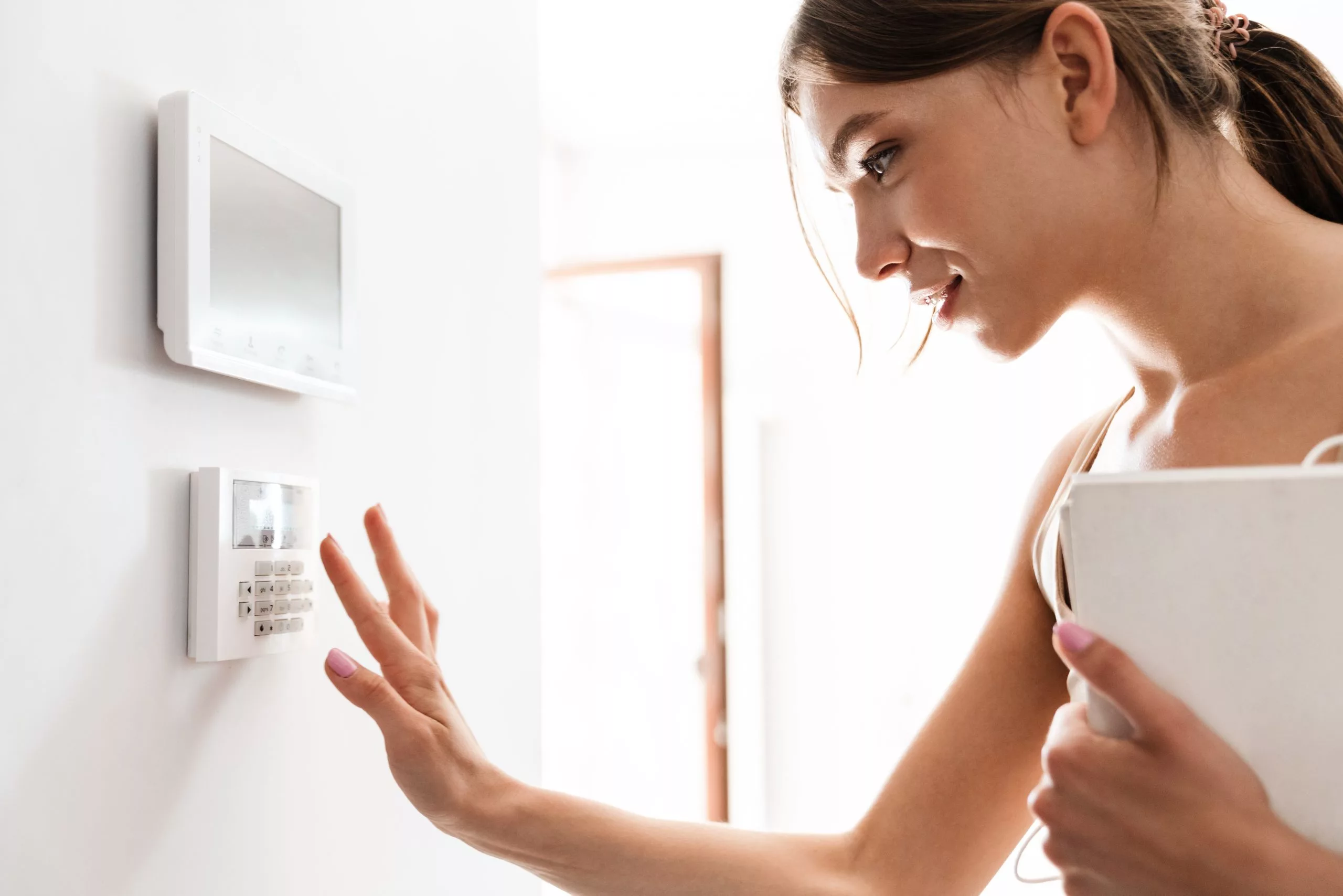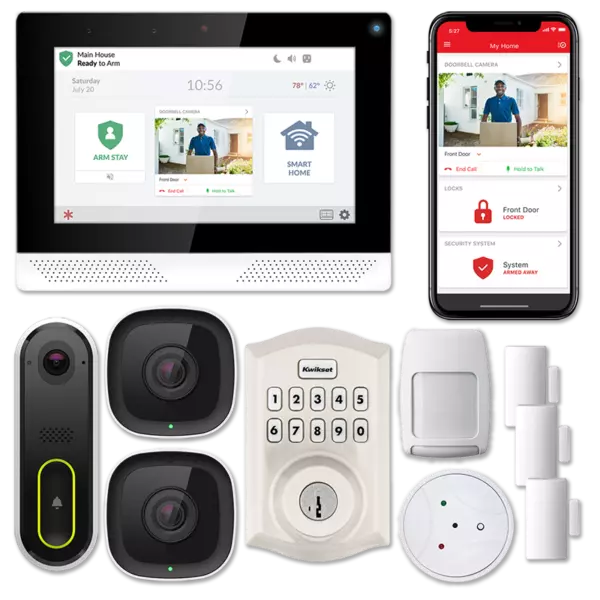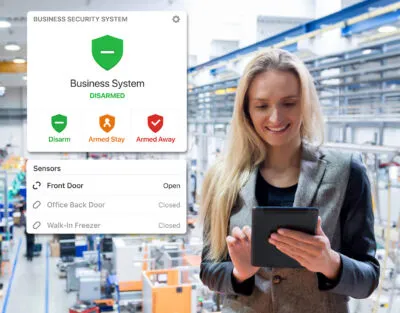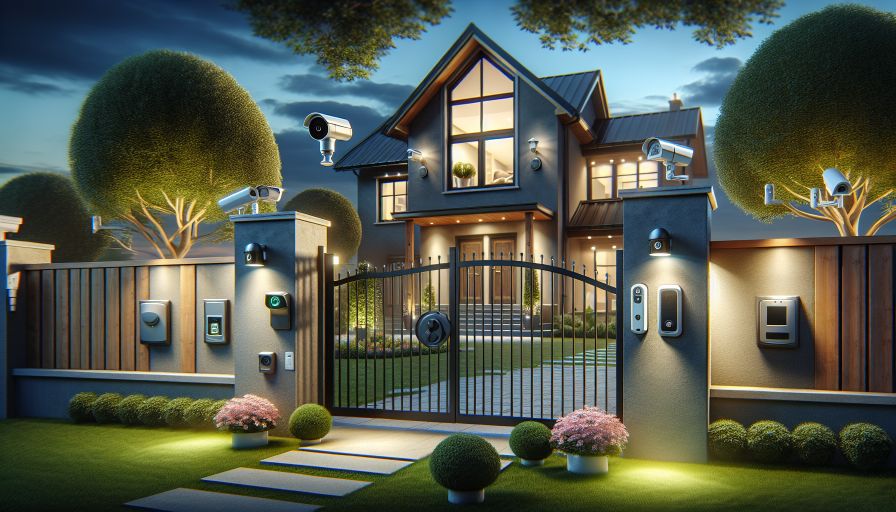- Introduction to Home Security Systems
- The Evolution of Home Security Technology
- Understanding Modern Threats to Home Security
- Fundamentals of a Bulletproof Home Security System
- Key Components of Effective Home Security
- The Role of Surveillance and Monitoring
- Advanced Security Technologies and Innovations
- Importance of Cybersecurity in Home Security Systems
- Cost vs. Benefit Analysis of Home Security Investments
- Government Regulations and Industry Standards
- Case Studies of Successful Home Security Implementations
- Future Trends in Home Security
Introduction to Home Security Systems
Home security systems have become an integral part of residential safety in today’s world. These systems are designed to protect homes from various threats including burglary, fire, and environmental hazards. The primary goal is to provide peace of mind by ensuring the safety of residents and their belongings. This chapter will provide a foundational understanding of what home security systems are and their significance.

Home Security System Panel
What is a Home Security System?
A home security system is a network of integrated devices and components designed to protect property from intrusions, theft, and other emergencies. It typically includes a combination of hardware such as cameras, sensors, alarms, locks, and software for monitoring and control.
Importance of Home Security Systems
Home security systems play a crucial role in safeguarding homes. Some key benefits include:
- Deterrence of Criminal Activity: The presence of a security system can deter criminals. Visible cameras and alarm systems make homes less attractive targets for burglars.
- Protection of Valuables: Security systems help protect valuable possessions by alerting homeowners and authorities during a break-in or fire.
- Remote Monitoring: Modern systems allow homeowners to monitor their property remotely through smartphones or computers, providing real-time updates and alerts.
- Fire and Gas Leak Protection: Integrated smoke and carbon monoxide detectors can provide early warnings, helping to prevent potential disasters.
- Insurance Benefits: Many insurance companies offer discounts on homeowner’s insurance premiums for homes equipped with security systems.

True Ultimate Smart Home Security Systems
Basic Components of a Home Security System
Understanding the basic components that make up a home security system is essential. These typically include:
- Control Panel: The central hub that controls the entire security system.
- Sensors: Devices placed on doors and windows to detect opening and closing. Motion sensors detect movement within the home.
- Alarms: Loud sounds designed to alert residents and neighbors of a potential intruder or emergency.
- Security Cameras: Provide video surveillance and can be accessed remotely.
- Communication Devices: Systems that facilitate communication with monitoring services or authorities in case of an emergency.
The Growing Necessity for Home Security
The need for home security systems has grown over the years due to various factors, including rising crime rates and technological advancements. Homeowners today have access to more sophisticated and affordable security solutions than ever before, making it easier to protect their homes.
In conclusion, home security systems are an essential investment for protecting homes and providing peace of mind. By understanding their components and benefits, homeowners can make informed decisions on the best security solutions for their needs.
The Evolution of Home Security Technology
The evolution of home security technology has been profound, changing drastically from simple mechanical locks to sophisticated, interconnected systems. This transformation has been driven by advancements in technology and the increasing need for comprehensive security solutions.
Early alarm systems primarily consisted of basic physical barriers, such as locks and window bars. However, as these methods proved insufficient against evolving threats, the integration of electronic components began. The advent of the electric telegraph in the mid-19th century paved the way for the first burglar alarms, which used magnetic contacts to sense when doors or windows were opened.
| Technology | Advancement |
|---|---|
| Locks and Bars | Mechanical components for basic physical security |
| Electric Burglar Alarms | Used magnetic contacts to detect door/window breaches |
| Motion Detectors | Ultrasonic and PIR sensors for detecting movement and heat signatures |
| Surveillance Cameras | Transition from analog to digital, enabling remote monitoring and advanced analytics |
In recent decades, home security systems have become more integrated and intelligent. The rise of the Internet of Things (IoT) has enabled the connection of various devices, such as cameras, sensors, and alarms, allowing for a centralized security network. Smart home platforms like those offered by companies such as ADT, SimpliSafe, and Ring provide users with control over their home security through mobile applications, offering real-time notifications and the ability to arm or disarm systems remotely.
Overall, the evolution of home security technology reflects the continuous efforts to enhance safety and address emerging challenges. As technological advancements continue, home security systems are expected to become even more sophisticated, offering higher levels of protection and peace of mind for homeowners.
Understanding Modern Threats to Home Security
Modern home security systems face an array of threats, some of which are continuously evolving with advancements in technology. Understanding these threats helps build a resilient defense mechanism, ensuring the safety and security of your household.
Physical Intrusions: Traditional burglary and forced entry remain prevalent. Crime statistics from the FBI indicates that in 2019, there were over 1.1 million burglaries in the United States alone. These intrusions often involve door and window break-ins, and they typically occur in residential areas. Effective solutions include reinforced doors, shatter-proof windows, and advanced locking mechanisms.
Technological Threats: As home security systems become more interconnected and reliant on the internet, they are increasingly susceptible to cyberattacks. Hackers can exploit vulnerabilities in smart home devices, gaining unauthorized access to security cameras, alarms, and other systems. According to Symantec’s 2020 Internet Security Threat Report, IoT (Internet of Things) devices experienced a 600% increase in attacks compared to the previous year.
Social Engineering: This threat involves manipulating individuals into compromising security through human interaction. Tactics include impersonation, pretexting, and phishing, where attackers trick homeowners into divulging confidential information or disabling security features. Education and awareness are key defenses against social engineering.
Below is a summary table of common threats and corresponding preventive measures:
| Threat | Preventive Measures |
|---|---|
| Physical Intrusions | Reinforced doors, shatter-proof windows, advanced locking systems |
| Technological Threats | Strong passwords, regular software updates, network encryption |
| Social Engineering | Education, awareness, verification protocols |
It’s essential to integrate a combination of physical and digital security measures to safeguard against these modern threats. By understanding and addressing these risks, homeowners can create a more secure living environment.
Fundamentals of a Bulletproof Home Security System
Creating a robust home security system that can withstand various threats demands a thorough understanding of its fundamental elements. These fundamentals include physical barriers, detection mechanisms, and deterrents that collectively fortify the safety of your home.
Physical Barriers
Physical barriers are the first line of defense in any home security system. These include structures and installations that prevent unauthorized access to your property. Common examples include:
- Doors and Locks: High-quality deadbolts, smart locks, and reinforced doors.
- Windows: Impact-resistant glass, window bars, and secure latches.
- Fencing: Tall, sturdy fences with lockable gates.
- Security Doors: Screen doors with steel mesh and tamper-resistant features.
Detection Mechanisms
Detection mechanisms help identify unauthorized entries or suspicious activities at an early stage. Key detection tools include:
- Alarm Systems: Audible alarms triggered by break-ins, often integrated with security services for immediate response.
- Motion Sensors: Devices that detect movement in specific areas, typically used indoors and outdoors.
- Glass Break Sensors: Sensors that detect the sound of glass breaking and can notify homeowners or security services.
- Door/Window Sensors: Magnetic sensors that alert when doors or windows are opened without authorization.
Deterrents
Deterrents aim to discourage potential intruders from targeting your property. Effective deterrents include:
- Exterior Lighting: Strategically placed lights around the perimeter, especially motion-activated lights.
- Security Cameras: Visible cameras that record activities and serve as a warning to would-be intruders.
- Security Signs: Signs indicating the presence of a security system, such as “Protected by XYZ Security.”
- Guard Dogs: Presence of trained dogs can be a formidable deterrent to intruders.
In conclusion, the fundamentals of a bulletproof home security system require a multifaceted approach combining physical barriers, detection mechanisms, and deterrents. By integrating these elements, homeowners can significantly enhance the security and safety of their living spaces.
Key Components of Effective Home Security
When it comes to establishing a robust home security system, understanding the key components that contribute to its effectiveness is crucial. These components work in unison to provide a comprehensive shield against various security breaches.
1. Alarm Systems
Alarm systems are fundamental to any home security setup. They serve as the first line of defense by alerting homeowners and authorities about unauthorized entry or suspicious activities. The main types of alarms include:
- Intrusion Alarms: Detects unauthorized entry into the property.
- Fire Alarms: Provides alerts in case of smoke or fire.
- Carbon Monoxide Alarms: Monitors and warns about harmful levels of CO gas.
2. Surveillance Cameras
Surveillance cameras play a vital role in modern home security. They not only act as a deterrent but also provide critical evidence in case of incidents. Key aspects include:
- Placement: Strategically place cameras at entry points, garages, and less visible areas.
- Technology: Utilize high-definition, infrared, and motion-detection cameras for better monitoring.
- Storage: Ensure proper storage solutions, such as cloud storage or local devices, to retain footage.
3. Access Control Systems
Effective access control systems manage entry to your property, making sure only authorized individuals can gain access. These systems can include:
- Smart Locks: Allow homeowners to control locks via smartphones, offering both convenience and security.
- Biometric Systems: Utilize fingerprint or facial recognition for entry, ensuring higher levels of security.
- Keypads and Card Readers: Require a code or card swipe for access, offering customizable entry options.
4. Lighting Systems
Security lighting helps to deter criminal activities by illuminating key areas of the property. Types of security lighting include:
- Motion-Activated Lights: Turn on when movement is detected, surprising potential intruders.
- Floodlights: Cover large areas with bright light, typically used for yards or driveways.
- Timer-Based Lights: Simulate occupancy by turning on/off at scheduled times.
5. Environmental Sensors
Besides detecting unauthorized entry, environmental sensors provide additional layers of protection. Common sensors include:
- Water Leak Sensors: Detect water presence and notify homeowners to prevent water damage.
- Temperature Sensors: Monitor temperature changes to protect against extreme cold or heat.
- Glass Break Sensors: Detect the sound of breaking glass to alert about potential window breaches.
Incorporating these components effectively creates a secure environment, providing peace of mind and enhanced safety for homeowners. It’s imperative to tailor these components based on specific household needs and vulnerabilities to maximize the effectiveness of the home security system.
The Role of Surveillance and Monitoring

Business Security Systems
In modern home security systems, surveillance and monitoring play a crucial role in ensuring the safety and security of residential properties. Continuous monitoring and effective surveillance help in early detection of suspicious activities, enabling homeowners and authorities to respond promptly.
Importance of Surveillance Systems
Surveillance systems are essential for the following reasons:
- Deterrence: Visible security cameras can deter potential intruders from attempting to break into a property.
- Evidence Collection: Recorded footage can serve as critical evidence in the event of a security breach or criminal activity.
- Continuous Monitoring: Round-the-clock monitoring ensures that any unusual or suspicious activity is detected and addressed promptly.
Types of Surveillance Systems
There are several types of surveillance systems commonly used in home security:
| Type | Features |
|---|---|
| Analog Cameras | Basic technology, requires a DVR (Digital Video Recorder), lower resolution |
| IP Cameras | High-resolution, internet-connected, can be integrated with other smart home devices |
| Wireless Cameras | Easy to install, flexible placement, may require battery replacement |
Monitoring Services
In addition to surveillance cameras, professional monitoring services add another layer of security. These services typically involve:
- 24/7 Monitoring: Continuous supervision by security professionals who can alert authorities if necessary.
- Emergency Response: Immediate contact with law enforcement, fire, or medical services in the event of an emergency.
- Remote Monitoring: Homeowners can monitor their property in real-time through mobile apps or web platforms.
Data Privacy and Security
With the increasing use of surveillance systems, data privacy and security are paramount. Homeowners should ensure:
- Secure Network: Use encrypted networks to prevent unauthorized access to surveillance feeds.
- Data Protection: Regularly update software and firmware to protect against vulnerabilities.
- Access Control: Limit who can view and manage surveillance system data.
In conclusion, effective surveillance and monitoring are indispensable components of a robust home security system. By understanding the various types of surveillance systems, utilizing professional monitoring services, and ensuring data privacy and security, homeowners can significantly enhance their property’s protection.
Advanced Security Technologies and Innovations

Advanced security technologies and innovations have dramatically transformed the landscape of home protection. Over the past decade, the integration of cutting-edge tools and methodologies has enhanced residential security systems, making homes safer and more resilient to modern threats.
Smart Home Integration
One of the most significant advancements in home security is the integration of smart home technologies. These systems allow for seamless control and monitoring of various security components through a centralized platform, often accessible via a smartphone app. Key features include:
- Remote Monitoring and Control: Homeowners can monitor security cameras, door locks, and alarm systems from anywhere in the world.
- Automation: Automated routines can be set up, such as locking doors at a certain time or turning on lights when motion is detected.
- Voice Control: Integration with virtual assistants like Amazon Alexa or Google Assistant allows for voice commands to control security systems.
Artificial Intelligence (AI) and Machine Learning
AI and machine learning technologies have significantly enhanced the capabilities of home security systems. These technologies provide:
- Enhanced Motion Detection: AI algorithms can differentiate between humans, animals, and other moving objects, reducing false alarms.
- Facial Recognition: Advanced cameras can identify known individuals and alert homeowners to unknown visitors.
- Behavioral Analysis: Machine learning can analyze patterns of activity and identify unusual behavior, prompting alerts.
Biometric Security
Biometric technologies have become increasingly prevalent in home security systems. Some popular biometric methods include:
- Fingerprint Scanners: Used for securing doors and safes, providing a highly secure access method.
- Retina Scanners: More advanced, though less common, these provide one of the highest levels of security verification.
- Facial Recognition: Integrated into smart locks and surveillance systems to permit or deny access based on facial features.
Internet of Things (IoT)
The Internet of Things has enabled various devices to interconnect, offering enhanced functionality and security. IoT features in home security include:
- Interconnected Devices: Security cameras, smart locks, sensors, and alarms work together to provide comprehensive coverage.
- Real-time Alerts: Sensors can transmit real-time data to alert homeowners of potential security breaches.
- Smart Analytics: IoT-enabled devices collect data to improve system efficiency and response times.
Blockchain Technology
Blockchain technology is emerging as a novel approach to enhancing security systems. Its applications include:
- Data Integrity: Blockchain ensures tamper-proof storage of security footage and logs.
- Decentralized Networks: Reduces the risk of a single point of failure by distributing data across multiple nodes.
- Secure Authentication: Blockchain can provide secure methods for verifying user identities.
These advanced security technologies and innovations represent the forefront of home security, providing homeowners with more robust and reliable systems to safeguard their properties. By staying informed about these developments, homeowners can make educated decisions to enhance their security measures effectively.
Importance of Cybersecurity in Home Security Systems
The integration of cybersecurity into home security systems is increasingly vital as the digital landscape evolves. With the rise in the number of smart devices and interconnected systems, the vulnerability to cyber-attacks has significantly increased. Ensuring that your home security system is cyber-secure means protecting not only your physical assets but also sensitive personal data.
Regular updates and patch management are also crucial components of a secure home security system. Manufacturers periodically release firmware updates to patch security vulnerabilities and enhance system performance. Ensuring that your system is up-to-date with the latest patches can prevent exploitation of known security flaws by malicious actors.
Network security remains a cornerstone of cybersecurity for home security systems. Securing your Wi-Fi network with strong passwords, employing WPA3 encryption, and hiding the network SSID can mitigate unauthorized access. Moreover, segmenting your home network by creating a separate network for security devices can isolate them from other potentially less secure devices.
Understanding and implementing these cybersecurity measures can significantly enhance the security of your home security system and safeguard against emerging cyber threats.
Cost vs. Benefit Analysis of Home Security Investments
When evaluating the cost versus benefit of home security investments, it is crucial to consider both the initial expenses and the long-term value derived from securing one’s home. This chapter aims to provide an objective analysis of the financial implications of investing in a robust home security system.
Initial Costs of Home Security Systems
Home security systems typically involve several upfront costs, including equipment purchase, installation fees, and potential activation charges. Here is a basic breakdown of initial costs:
| Component | Average Cost (USD) |
|---|---|
| Equipment (cameras, sensors, alarms, control panel) | $200 – $1,500 |
| Professional Installation | $100 – $500 |
| Activation Fees | $0 – $200 |
Ongoing Costs
Beyond the initial outlay, maintaining a home security system involves recurring expenses. These may include monthly monitoring fees, maintenance, and potential costs for upgrades. The typical ongoing costs include:
- Monthly Monitoring Fees: Ranges from $10 to $60, depending on the provider and level of service.
- Maintenance: Periodic costs for replacing batteries, servicing equipment, or subscribing to software updates.
Benefits of Investing in Home Security
While the costs can accumulate, the benefits of a secure home often outweigh these expenses. Key benefits include:
- Deterrence of Crime: Studies show that homes with security systems are less likely to be targeted by burglars.
- Peace of Mind: Knowing that your home is protected can significantly reduce stress and anxiety.
- Potential Insurance Discounts: Many insurance companies offer discounts on home insurance premiums for homes equipped with security systems, which can partially offset costs.
Cost-Benefit Analysis
An effective way to understand the overall value of a home security system is through a cost-benefit analysis. Consider the annual investment compared to potential losses without security:
| Consideration | Estimated Value (USD) |
|---|---|
| Annual Security System Cost | $300 – $1,020 |
| Average Loss Per Burglary (FBI Data) | $2,661 |
The data indicates that the financial impact of a burglary can far exceed the annual cost of maintaining a security system. Additionally, the intangible benefits such as peace of mind and increased safety further enhance the overall value proposition.
Conclusion
Ultimately, the decision to invest in a home security system should be informed by a thorough cost vs. benefit analysis. While the initial and ongoing expenses can be significant, the potential savings from preventing crime, along with the added peace of mind and possible insurance benefits, generally justify the investment.
Government Regulations and Industry Standards
Understanding the regulatory landscape and adhering to industry standards is crucial for any home security system. Governments worldwide have established regulations to ensure the safety, quality, and effectiveness of these systems. Additionally, industry standards help maintain consistency and reliability across products and services.
Government Regulations
In many countries, home security systems are subject to a range of regulatory requirements. For instance, in the United States, the Federal Communications Commission (FCC) regulates wireless communication devices used in security systems to ensure they do not interfere with other essential services. Compliance with FCC regulations is mandatory for all manufacturers of security devices.
Furthermore, the Federal Trade Commission (FTC) enforces rules on the privacy and security of consumer data. This includes the data collected by home security systems, such as video footage and personal information.
Industry Standards
Adherence to industry standards is essential for ensuring the consistency and quality of home security systems. Some of the key standards relevant to the industry include:
- UL Certification: Underwriters Laboratories (UL) provides certification for security products that meet specific safety and performance criteria. Products that receive UL certification have undergone rigorous testing and evaluation.
- ISO/IEC 15408: Also known as the Common Criteria, this international standard provides guidelines for the evaluation and certification of information security products, which include cybersecurity aspects of home security systems.
- CSA STAR: The Cloud Security Alliance (CSA) Security, Trust & Assurance Registry (STAR) certification ensures that cloud-based security services comply with comprehensive standards for data protection and governance.
Compliance and Consumer Protection
Meeting regulatory and industry standards is not only about adhering to legal requirements but also about ensuring consumer protection. Homeowners rely on security systems to safeguard their property and personal information, and compliance with these standards helps build trust and credibility.
Many countries have consumer protection laws that hold manufacturers and service providers accountable for the performance and reliability of their security systems. By complying with these regulations, companies can reduce the risk of legal issues and improve customer satisfaction.
In conclusion, government regulations and industry standards play a vital role in the home security industry. They ensure the safety, effectiveness, and reliability of security systems, while also protecting consumer rights and data privacy. For homeowners, choosing a security system that complies with these standards is a key step in creating a safe and secure living environment.
Case Studies of Successful Home Security Implementations
True Protection has earned its reputation as the leading security system provider through its commitment to delivering customized home security systems that cater to a diverse range of needs. With presence in five Texas locations—Austin, San Antonio, Houston, Dallas/Fort Worth, and more—True Protection ensures that both home and business owners receive the highest level of security and peace of mind.
An award-winning company, True Protection is lauded for offering great deals on the latest security and surveillance systems. By keeping up with advancements in technology, they ensure their clients benefit from cutting-edge security solutions. Some of the advanced technologies offered include high-definition surveillance cameras, smart locks, motion sensors, and integrated home automation systems. With these tools, True Protection helps clients achieve a robust, all-encompassing security environment.
Clients across Texas have consistently praised True Protection for its reliability and excellent customer service. The company’s dedication to client satisfaction is reflected in the seamless implementation and ongoing support offered post-installation. Whether it’s a home or a small business, True Protection ensures that the security systems are easy to use yet uncompromising in their effectiveness.
Future Trends in Home Security
The field of home security is rapidly evolving due to advances in technology, changes in societal behaviors, and emerging threats. Understanding future trends is crucial for both homeowners and security providers to stay ahead in protecting residential properties.
Integration of Artificial Intelligence (AI) and Machine Learning
AI and machine learning are set to revolutionize home security systems. These technologies enable security systems to learn from data and improve over time. For instance, AI-powered cameras can differentiate between a potential intruder and a harmless passerby, significantly reducing false alarms. Moreover, predictive analytics can identify unusual patterns and preemptively alert homeowners or authorities.
Smart Home Integration
Smart home devices are increasingly being integrated with security systems, offering seamless control over various aspects of home security. This involves connecting alarms, cameras, locks, and lighting systems to central hubs, like smart speakers or dedicated home security apps. Such integration allows for remote management, where homeowners can arm or disarm systems, check live feeds, and receive real-time alerts, all from their smartphones.
Biometric Authentication
The use of biometric authentication is on the rise for home security, replacing or supplementing traditional keys and passcodes. Systems using facial recognition, fingerprint scanning, and even voice recognition add an extra layer of security, making unauthorized access more difficult. These technologies are becoming more affordable and reliable, contributing to their increased adoption.
Enhanced Cybersecurity Measures
As home security systems become more interconnected, the threat of cyberattacks looms larger. Future trends emphasize stronger cybersecurity measures to protect interconnected devices and the personal data they collect. This includes implementing robust encryption protocols, regular software updates, and the use of secure, cloud-based services to handle sensitive information.
DIY Home Security Solutions
The market has seen a rise in do-it-yourself (DIY) home security systems. These systems are designed for easy installation and user-friendly operation. They often come in modular kits, allowing homeowners to customize and expand their security setup as needed. Although these systems typically offer lower upfront costs, ongoing support and system scalability are also key factors to consider.
Environmental and Energy Efficiency Considerations
Sustainability is an emerging trend within home security. Future systems are likely to incorporate energy-efficient components and eco-friendly designs. This includes solar-powered cameras and motion sensors, as well as systems that minimize electricity consumption without compromising security effectiveness.
In conclusion, staying updated on future trends in home security helps homeowners and providers to anticipate and mitigate potential risks. Ultimately, the aim is to create a secure living environment that is both reliable and adaptive to changing technological and social landscapes.

